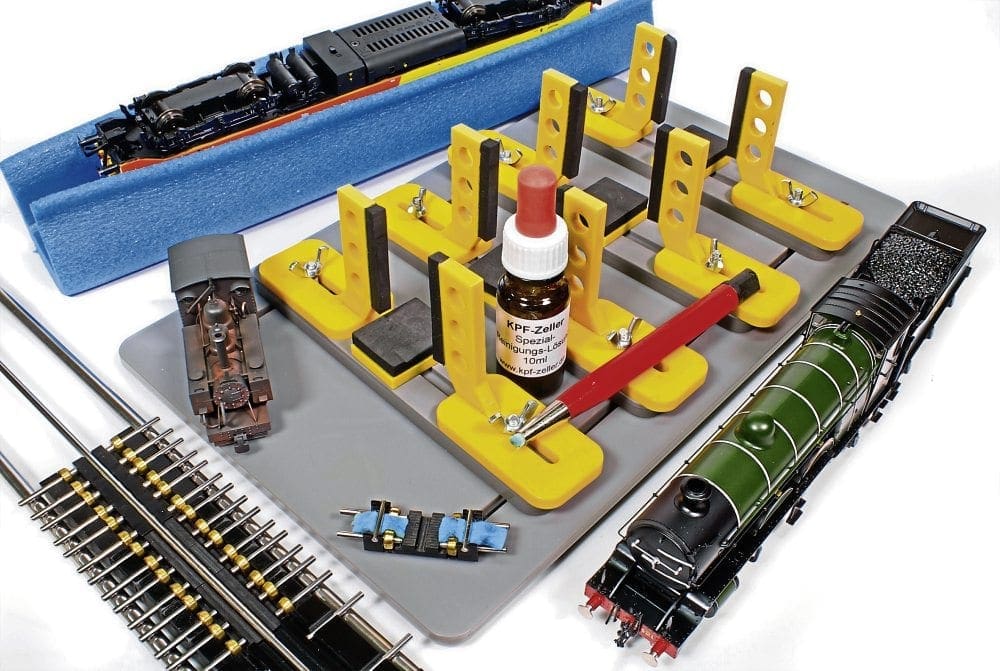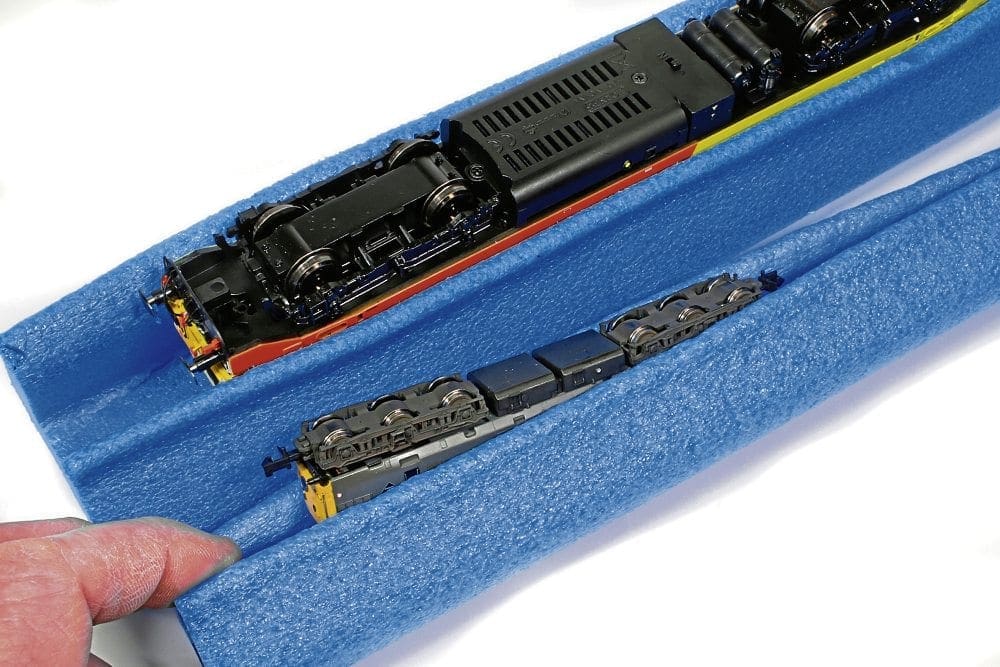The Railway Magazine Guide to Modelling brings some handy tips and techniques for cleaning the wheels of locomotives and rolling stock in order to get the best performance from your models.
One feature of modelling that we take for granted is the use of the two running rails to conduct power to our model locomotives. This connection is technically wireless, with power being conducted through the wheel-to-rail interface. Unlike slot cars, it allows scale modelling without any compromise in the appearance of the track, but on the flip side, the same contact between rail and wheels, together with a similar contact between the wheels and electrical circuits within the model, is a potential weakness.
For fine control and good running characteristics, both of these points of contact have to be very good, yet they are prone to a number of difficulties, the primary one being the build-up of dirt.
This article focuses on maintaining the contact between rail and wheel for the best electrical conductivity, and that means keeping wheels as clean as the track, a subject that was also covered in the last issue of RMM because the two are linked.
Wheel-cleaning can be as much of a chore as cleaning track, but with models being equipped with a good amount of weight, together with the increasing use of pick-ups on all available wheels, continuity of power from rail to the model is not as great a problem as in the past, even with smaller scales such as OO9 and N gauge, where models rarely tip the scales at more than 100g. Nonetheless, the need to clean wheels soon crops up when locomotive performance loses its edge.

Wheels become dirty for several reasons, the primary one being running models on dirty track. Keep the track clean, as described in the last issue of RMM, and the build-up of the grot and grime that collects on the rail head is reduced. It’s the same dirt, collected as wheels rotate until electrical contact is lost. The same thing also happens to the wheels of rolling stock, eventually causing them to lose their smooth tyre surface, resulting in increased noise and rougher riding – something that’s particularly noticeable in smaller scales.
The second, and less common reason for poor contact between wheel and rail, is tarnish, which occurs when models are used infrequently. Undoubtedly a few minutes of track and wheel cleaning, combined with regular use of the layout, avoids a lot of problems.
Simple cleaning methods
There are numerous ways of cleaning wheels, and everyone has a favourite technique. Some are dead simple whereas others use quite sophisticated systems. Abrasive cleaning is popular with many modellers, and newcomers to the hobby usually try abrasive methods first simply because they are the simplest ones to use, and there’s little wrong in using a gentle abrasive action to put a shine on the wheels once again.
Choosing the right tools is important when doing this work, because excessively abrasive materials will do more harm than good. Running a fibre scratch pencil along the wheel tread and flange will gently clean the build-up of tarnish and grime away, burnishing the surface to a shine and with minimal wear. It’s also a good method to use to remove blackening from the wheels of new models before putting them into traffic.
Avoid tools that use wire, even soft brass wire, because it damages the tyre surface. The wire brush tool provided in many mini-drill kits should be avoided, and those cleaning tools that are designed for model railways consisting of a wire brush which doubles as a contact to supply electrical power should be used only on coarse-scale wheels or those with a particularly heavy build-up of dirt – and gently too!
Models with finer RP25/110 or RP25/88 wheels sets are easily damaged. While it will not be immediately apparent, the relatively soft metals used in ready-to-run locomotive wheels are easily scratched. Scratches cause accelerated dirt accumulation which is all the more difficult to remove, making the problem potentially worse in the long term.
Using chemicals
The same chemicals that clean rails can also clean wheels. A number of gentle solvents have been developed for just this sort of job, and they are very effective on track including Carr’s cleaner; the fluid in Deluxe Materials’ ‘Track Magic’ and Slater’s track-cleaning fluid. By placing a model in a cradle or stand such as those sold under the Proses label, the wheels can be rotated at half speed and wheels gently cleaned with cleaning fluids applied to a cloth – avoid cotton buds because the fibres could become tangled in gears or the axles.
It is important to check that chemicals do not damage paint finishes. You don’t want to wear paint from steam locomotive wheels or damage the paint on the bogie sideframes of diesel and electric locomotive models. Whilst isopropyl alcohol (IPA) is an excellent solvent to use for a variety of model cleaning jobs, including rails and wheels, it will remove factory-applied paint finishes and acrylic hobby paint, so use it with care.
A simple way to use a solvent cleaner, particularly in OO9 and N gauges, is to moisten a piece of good-quality kitchen towel with IPA or cleaning fluid. Place it over a piece of track and hook up the power leads. With one bogie or tender of the model with pick-ups on the track and the driving wheels or opposite bogie positioned on the towel, hold the model on the track and run it gently at around 30% of its usual speed to rotate the wheels on the towel for about 15 seconds. The dirt that appears on the towel can be unbelievable, even when the wheels look clean to the eye!

Wheel cleaning devices
In common with track cleaning and many other areas of the hobby, a range of products for wheel cleaning are widely available. A common type is the wire brush cleaner, which should be used with a degree of caution to avoid excessively scratching the surface of the wheel tyre. They take advantage of being able to conduct track power through the cleaner to keep the wheels rotating. Several versions are available, including the Kadee ‘Speedi’ wheel cleaner and the Gaugemaster wheel-cleaning brush which is similar to the Marklin/Trix device for N gauge. They do have the advantage of being dry cleaning systems not requiring solvents, and are particularly effective on heavy dirt build-up.
A gentle wheel cleaner which uses track power to rotate locomotive wheels is the Woodland Scenics ‘Roto’ wheel cleaner. It has a length of track built into it with fabric cleaning strips on each side. The locomotive wheels rotate while making contact with the fabric strips to remove grime build-up. It may be used for cleaning rolling stock wheels too, by simply running the coach or wagon up and down the cleaner.
Rolling road cleaning attachments are growing in popularity and can be used to clean wheels while a model is running in or being examined. The KPF Zeller OO/HO rolling road has separate cleaning attachments that are positioned under each driving wheel in turn, effectively cleaning the wheels as they rotate. The Proses rolling road also has wheel cleaning devices that work in the same manner. They can be used with a cleaning solvent or dry to save mess – but no matter which type of device you choose to use, never run the model at full speed.


